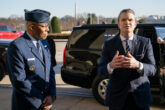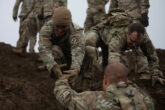September 20, 2018
Veterans: Answering the call to serve
In August, the veteran unemployment rate was 3.8 percent – the same as that for non-veterans – continuing a multi-year positive trend. The same month, Google announced that it was adding a feature allowing vets to plug their MOS into a job search to find suitable openings.
As with many initiatives designed to help veterans, this led me to a mixed reaction: while I’m pleased to see efforts to support my fellow veterans during our transitions out of the military and beyond, I am simultaneously frustrated at the ongoing perception that we, who volunteered to serve, now need to be served. For most veterans, service is connected with positive outcomes: we are less likely to live in poverty than those who have not served, and have higher education levels and wages. Not only that, but for many of us, the desire to serve continues beyond active duty. According to Got Your Six analysis, veterans volunteer, vote, donate to charity, and are involved with local communities at higher rates than non-veterans.
The volume of this volunteering is astonishing in scope and scale. To give just a few examples: In 2016, nearly 2,000 volunteers logged over 100,000 hours on Team Rubicon disaster relief operations around the globe. Nearly 7,000 American Legion volunteers collectively serve 900,000 hours annually at VA Medical Centers alone. Roughly 17,500 Mission Continues volunteers contributed nearly 200,000 hours of service in hundreds of communities nationwide in 2016. DAV volunteer drivers traveled over 18 million miles, providing over 600,000 rides to veterans and donating nearly 1.5 million hours of their time in 2017 alone.
This outpouring of service to – and with – our communities brings a sense of purpose and meaning that many feel we have lost when we leave the military, along with a deeper level of connection to others. Finding new ways to serve can be an important component of reintegration, with benefits accruing not only to others but also to the self. This has absolutely been true for me. It was deeply disorienting to transition out of my structured military life with its intimate personal connections and clearly defined mission to one in which I had to chart my own path in a city of strangers. Advocating for issues that mattered to me as part of a community brought gravity and focus that kept me moving forward.
Read the Full Article at The Hill
More from CNAS
-
The Department of Defense’s Breakthrough Nuclear Moment Risks Slipping Away
Unless they act, the Department of Defense’s breakthrough nuclear moment may vanish before it really happens....
By Will Rogers
-
Sharper: National Security Human Capital
U.S. national security depends on the nation’s ability to leverage the expertise of uniformed warfighters and the highly skilled civilian professionals who develop and impleme...
By Charles Horn & Taren Sylvester
-
Hegseth Brings the Culture War to Combat
The fundamental challenge of military leadership lies in creating cohesive teams that can work together in an environment of mortal risk and, when called upon to do so, use le...
By Dr. Jason Dempsey
-
Hegseth Says Trump Boosted Military Recruiting. It’s Been Improving for over a Year
Defense Secretary Pete Hegseth says military recruiting has shot up since the Trump administration's return. In fact, it's been improving for at least a year, with big jumps i...
By Taren Sylvester




